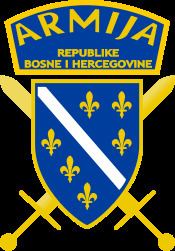Disbanded 14 December 1995 Founded 15 April 1992 | Defence Minister Munib Bisić | |
 | ||
Commander-in-Chief President Alija Izetbegović Commander General Sefer Halilović (1992-1993)General Rasim Delić (1993-1995) Active personnel 90-120,000 ~200,000 (in 1995) Similar Croatian Defence Council, Army of Republika Srpska, Yugoslav People's Army, Republic of Croatia Armed Fo, Armed Forces of Bosnia a | ||
The Army of the Republic of Bosnia and Herzegovina (Bosnian: Armija Republike Bosne i Hercegovine (ARBiH) / Армија Републике Босне и Херцеговине (АРБиХ)) was the military force of the Republic of Bosnia and Herzegovina established by the government of Bosnia and Herzegovina in 1992 following the outbreak of the Bosnian War. Following the end of the war, and the signing of the Dayton Peace Agreement in 1995, it was transformed into the Army of the Federation of Bosnia and Herzegovina. The ArBiH was the only military force on the territory of Bosnia and Herzegovina recognised as legal by other governments. Under the State Defense Reform Law the Armed Forces of Bosnia and Herzegovina were unified into a single structure, OSBiH, making entity armies defunct.
Contents
- Bosnian armed force s 2011 2012
- Creation and composition
- 1992
- 1993
- 1994
- 1995
- Army Corps and Commanding Officers
- Bosnian General Staff
- Corps commanders
- Equipment
- References
Bosnian armed force s 2011 2012
Creation and composition
The Army of Republic of Bosnia and Herzegovina was formed on 15 April 1992 during the early days of the Bosnian War. Before the ARBiH was officially created, a number of paramilitary and civil defense groups were established. The Patriotic League (PL) and the local Territorial Defence Force of the Republic of Bosnia and Hercegovina (TORBIH) were the official army while paramilitaries such as the Zelene Beretke (Green Berets) and Crni Labudovi (Black Swans) units were also active. Other irregular groups included Bosnian mafia groups, as well as collections of police and former Yugoslav People's Army soldiers.
The army was formed in poor circumstances, and suffered from a very limited supply of arms. Critical deficiencies included tanks and other heavy weaponry. The first commander of the army was Sefer Halilović.
1992
In 1992, 70% of Bosnia was under JNA (Yugoslav People's Army), and then later VRS (Bosnian Serb Army), control. Sarajevo was under siege. The ARBiH had defended Sarajevo with light weaponry. The army was surrounded and the transfer of supplies was hard, if not impossible.
1993
1993 saw no major changes in the front lines against Serbs. Instead, this year marked the start of the Croat-Bosniak war in Central Bosnia and in Herzegovina, notably the Mostar region. Pressured and contained by heavily armed Serb forces in Bosnia-Hercegovina and Croatia, Croat forces - HVO (Croatian Defence Council) shifted their focus from defending their parts of Bosnia from Serbs to trying to capture remaining territory held by Bosnian Army. It is widely believed that this was due to the Karađorđevo agreement reached between presidents Slobodan Milošević and Franjo Tuđman to split Bosnia between Croatia and Serbia. In order to accomplish this Croatian forces would have to defeat the Bosnian Army, since the territory that they wanted was under Bosnian government control. HVO with great engagement from the Military of Republic of Croatia and material support from Serbs, attacked Bosniak civilian population in Herzegovina and in central Bosnia starting an ethnic cleansing of Bosniak populated territories (e.g. Lašva Valley ethnic cleansing). Vastly underequipped Bosnian forces, fighting on two fronts, were able to repel Croats and gain territory against them on every front. At this time, due to its geographic position, Bosnia was surrounded by Croat and Serb forces from all sides. There was no way to import weapons or food. What saved Bosnia at this time was its vast industrial complex (steel and other heavy industry), which was able to switch to military production. After a short but bloody war, and once Croats realized that their partnership with Serbs would not bring them any territorial gains, they agreed to US leadership's "Washington Treaty" peace agreement. From that point on, Croat and Bosnian government forces fought as allies against Serbs.
1994
A renewed alliance between HVO and ARBiH was agreed upon, with the objective of forming a strong force that could fight the much stronger and better equipped VRS. This was the time of frequent peace negotiations.
1995
Despite the loss of several enclaves, notably Srebrenica, 1995 was marked by HVO and ARBiH offensives and later by NATO intervention. Following the Split Agreement, the Croatian army, with cooperation from ARBiH and HVO, launched a series of operations: Flash, Summer '95, Storm and Mistral 2. In conjunction, Bosnian forces launched operations like Sana. Bosnian and Croat armies were on the offensive in this phase, captured all of western Bosnia, and the Serb capital Banja Luka was seriously threatened, until peace negotiations stopped further bloodshed.
In the period of August–December 1995, Serb forces were defeated and driven out of the majority of Croatia and western Bosnia, and the ethnic Serb population fled from these parts.
Following the second Markale massacre, NATO intervention was launched, which destroyed much of the VRS infrastructure in just a few days (Operation Deliberate Force). The war ended with the signing of the Dayton Accord.
Army Corps and Commanding Officers
The army was divided into Corps, each stationed in a particular territory. In 1993, most brigades were renamed as Mountain troops given that the lack of heavy weapons made it organizationally pointless to list them as infantry or motorized. In addition, Bosnian terrain favored light infantry over armored and mechanized formations.
